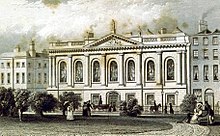
Sir Philip Crampton, 1st Baronet, FRSMRCSI was an eminent Irish surgeon and anatomist. He was President of the Royal College of Surgeons in Ireland (RCSI) in 1811, 1820, 1844 and 1855.

Sir Charles Alexander Cameron, CB was an Irish physician, chemist and writer prominent in the adoption of medical hygiene. For over fifty years he had charge of the Public Health Department of Dublin Corporation. He was elected President of the Royal College of Surgeons in Ireland (RCSI) in 1885.

Samuel Croker-King was an Irish surgeon who was associated with Doctor Steeven's Hospital in Dublin for sixty years. He was the first president of the Royal College of Surgeons in Ireland (RCSI), from 1784 to 1785. He is thought to have saved the life of the child who became the Duke of Wellington. He invented his own trepanning device.

Robert Bowes was the President of the Royal College of Surgeons in Ireland (RCSI) in 1787. He was Surgeon to the Charitable Infirmary, Inns Quay, Dublin, and also Surgeon to Simpson's Hospital. He was a member of the Dublin Society of Surgeons, who petitioned the King in 1781 for the foundation of the Royal College of Surgeons.

Philip Woodroffe was the resident surgeon at Dr Steevens' Hospital in Dublin for over 30 years. Several eminent surgeons were apprenticed to him. He was the president of the Royal College of Surgeons in Ireland (RCSI) in 1788.

Ralph Smith O'bré was an Irish physician who was the president of the Royal College of Surgeons in Ireland (RCSI) in 1790. He served as an army surgeon before setting up practice in Dublin where he became wealthy. He invented a popular double tracheostomy tube.

George Renny was the president of the Royal College of Surgeons in Ireland (RCSI) in 1793.

Solomon Richards was an Irish surgeon who served four terms as president of the Royal College of Surgeons in Ireland (RCSI) in 1794, 1803, 1808, and 1818. He achieved fame by performing a tracheotomy in public for which act he featured in a satirical poem in The Metropolis. He was praised for his philanthropy and noted for his puns and bon mots. He was said to be the "fattest surgeon in the United Kingdom".

Gustavus Hume was the president of the Royal College of Surgeons in Ireland (RCSI) in the first part of 1795. He specialised in the diseases of children. He was one of the surgeons who examined the body of the journalist William Jackson after he died from poisoning in a Dublin court in 1795 while awaiting sentencing for high treason.

Clement Archer was a surgeon and president of the Royal College of Surgeons in Ireland (RCSI).

James Rivers was the president of the Royal College of Surgeons in Ireland (RCSI) in 1801.

Robert Hamilton was the president of the Royal College of Surgeons in Ireland (RCSI) in 1805.

John Armstrong Garnett was the president of the Royal College of Surgeons in Ireland (RCSI) in 1810.

John Creighton was the president of the Royal College of Surgeons in Ireland (RCSI) in 1812 and 1824.

Patrick Cusack Roney or Rooney was an Irish physician who was President of the Royal College of Surgeons in Ireland (RCSI) in 1814 and 1828.

Charles Hawkes Todd was a medical doctor and the president of the Royal College of Surgeons in Ireland (RCSI) in 1821.

John Timothy Kirby was the president of the Royal College of Surgeons in Ireland (RCSI) in 1823 and 1834.

James William Cusack was the president of the Royal College of Surgeons in Ireland (RCSI) in 1827, 1847, and 1858.

Thomas Edward Beatty was an Irish physician, and the president of the Royal College of Surgeons in Ireland (RCSI) in 1850.

Andrew Ellis was the president of the Royal College of Surgeons in Ireland (RCSI) in 1849.







